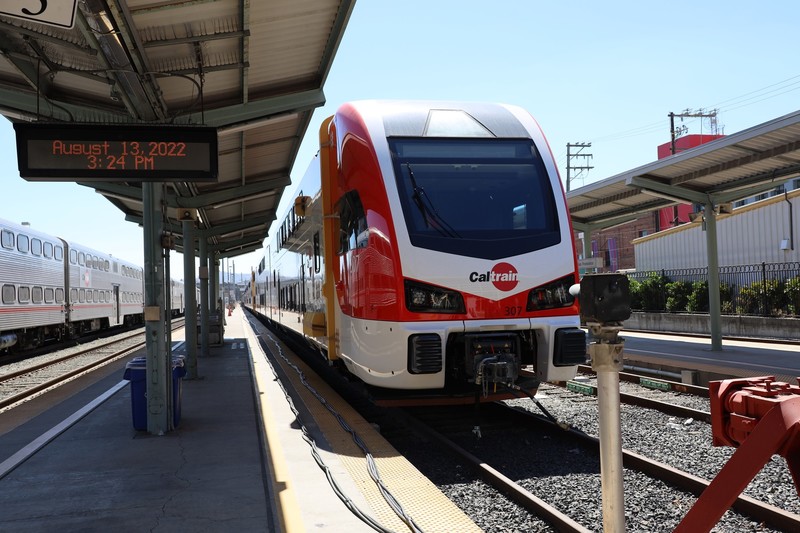The formal inauguration of Caltrain's groundbreaking electric train -- the first of its kind in California -- took place Saturday morning in San Francisco.
The event featured appearances from a bevy of politicians and other dignitaries who touted the project as a sign of renewed hope for modern trains and a forerunner to other such undertakings elsewhere.
The event started with a long lineup of short speeches -- including by House Speaker Emerita Nancy Pelosi, Gov. Gavin Newsom and San Francisco Mayor London Breed -- followed by a train ride to Millbrae and back, exclusive to the government, business and labor officials in attendance, along with the media.
"We're looking forward to having these trains move and groove, but you won't know it because they'll be so quiet," Breed said.
Caltrain, which broke ground on the $2.4 billion project in 2017, will phase in the electric trains among the existing diesel ones between now and Sept. 21, after which its fleet is expected to be entirely electric. Sunday is the first day the new trains will be used for public ridership.
Local officials described the project as a long-developing dream that finally materialized through staggering levels of interagency cooperation, the pooling of various funding sources and the circuitous navigation of a thorny political landscape.
"This is the spirit of California, and that spirit has alarmed the world," Newsom joked.
He said the trains would "set the model for the future of all rail across the country -- and when electric is the norm we will probably say, 'It all started here in San Francisco.'"
According to Caltrain spokesperson Dan Lieberman, the new trains will cut carbon dioxide emissions by 250,000 metric tons annually -- the equivalent of removing 55,000 cars from the road. He said other benefits include faster service (the electric trains accelerate and decelerate much more quickly), less noisiness, smoother rides and a host of new onboard amenities.
Get a weekly recap of the latest San Francisco Bay Area housing news. Sign up for NBC Bay Area’s Housing Deconstructed newsletter.
"There's Wi-Fi, plugs under every forward-facing seat, security cameras, digital displays, improved climate controls and redesigned accessible bathrooms," Lieberman said.
The Caltrain electrification project combines funding from numerous sources at all levels of government -- including over $2 billion combined from the federal and state governments, and about $250 million from local ballot measures, bridge toll funds, and contributions from the counties of San Francisco, San Mateo and Santa Clara.
"We had a lot of leadership on the federal, state and local level trying to get funding and get over the various political hurdles," Lieberman said.
Speakers at Saturday's event said Caltrain's electric railway is both a triumph in itself and a boost to California's own troubled plan to build high-speed rail from San Francisco to Los Angeles -- a project that ties in with Caltrain's electrification endeavor in some important ways.
The state's original high-speed rail plan, which had its funding approved by voters back in 2008, called for building new tracks along the entire rail line. That plan was later scrapped amid lawsuits from various cities on the Peninsula that objected to the construction.
It was replaced with a new plan that would share Caltrain's existing tracks, and then route the train through the Central Valley after the end of the Caltrain line in Gilroy (though Union Pacific, not Caltrain, owns the tracks between San Jose and Gilroy).
"They wanted to tear up the Peninsula and the cities were all suing -- it was a prairie fire," said U.S. Rep. Anna Eshoo, D-Palo Alto, as she hobnobbed with constant interlocutors during the train's 30-minute inaugural ride. "So we came up with the idea that the high-speed rail on the Peninsula would be the Caltrain rail."
The new plan -- and the federal funding its advocates secured -- gave new life to California's project, Eshoo said. It also helped bring in both state and federal funding for Caltrain's project because the success of that undertaking became critical to the high-speed rail plan.
"High-speed rail has helped us get the funding for Caltrain because eventually they'll be running on the same tracks," Lieberman said.
California's plans aside, Lieberman stressed that Caltrain's achievement was already monumental.
"This is a diesel to electric conversion -- the first project of its kind in a generation in North America," he said. "It's happened before, but I think it was back in like the 80s. This was a construction project along a 52-mile live rail corridor. And that is an incredibly complex undertaking that happened outside of our working schedule -- meaning a whole lot of late nights for the workers. So a huge amount of credit goes to the men and women who actually built this system."
Lieberman added that he expects Caltrain ridership levels to rebound after years of low numbers since the beginning of the COVID-19 pandemic.
"The choice between the gridlock of [U.S. Highway] 101 and riding on a beautiful, modern train -- that's not even a choice," he said.



